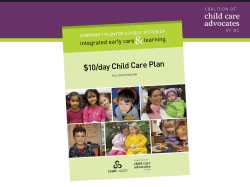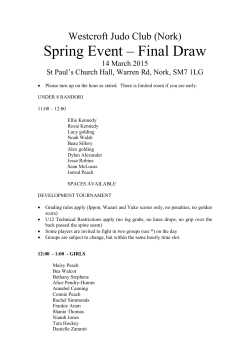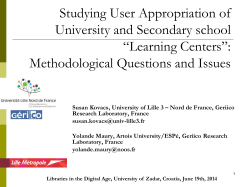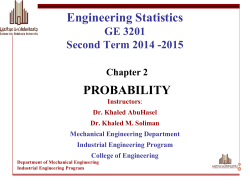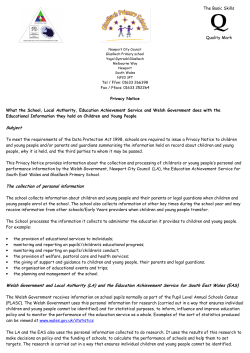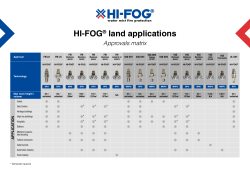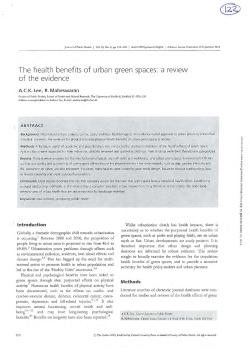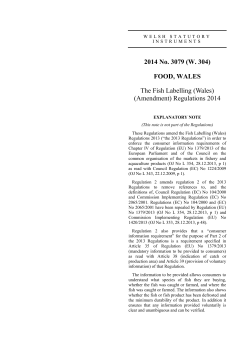
The role of adults in children’s play
The role of adults in children’s play Why play matters and what we can all do about it The importance of play in children’s lives has long been recognised by governments across the world. In 1989 140 countries signed up to a convention that sets out children’s rights. Known as the United Nations Convention on the Rights of the Child (UNCRC1) it grants over forty rights including the right to play, leisure and recreation. In Wales this agenda has been taken forward by the Welsh Government, in 2002 with the adoption of a play policy2 and most recently with the Children and Families (Wales) Measure 2010 which places a duty on local authorities to assess and secure sufficient play opportunities for children in their area. This legislation raises many important questions, not least one about why and how adults should provide for children’s play. Play is generally agreed to be something that children do quite naturally and instinctively. But if play is something children do quite naturally why do they need adult support at all? If children don’t need adults to play shouldn’t we just let them get on with it without interference? The answer is that ‘while play is a robust phenomenon… it can be compromised if conditions are not supportive’3. Play is crucial for children’s immediate and longer-term development and children who are significantly denied opportunities to play suffer serious negative effects to their health and wellbeing. The opportunities for children to play freely – particularly outdoors – have been significantly reduced in recent times. As adults we affect children’s play significantly: Permission When we reminisce about our childhoods many of us will recall happy times spent outdoors with friends far away from adults. Yet when we are asked about our own children there is usually a large ‘but’... followed by a host of reasons why things are different now. Parents are subject to intense peer pressure about their child rearing as well as being bombarded by powerful and sometimes contradictory messages from the media. It can be difficult to be objective about the real risks of adult free play. No parent wants to see their child hurt – indeed no adult wants to see any child hurt. But we know that keeping our children safe does not equal preventing them from playing – quite the reverse. Play is critically important; it is the way nature has designed how children learn about the world4. 3. We impact on the how and if space is made available (space) Permission to play is often all many children need to play and a shift in attitude to one that values play is the single biggest change that adults can make to support children’s play. To demonstrate a supportive attitude towards play we should ensure we do not: 4. We provide (or deny) materials (materials) • dismiss it as frivolous and a waste of time 1. We affect what children experience (permission) 2. We regulate time for play opportunities (time) • unnecessarily restrict it through fear • over regulate and over organise it • subvert it for other (adult) purposes To support children’s play we can listen to children! Children repeatedly tell us that they want access to places where they can play freely and safely but their voices are often unheard. When children are asked most say they want to play outside5. Children need opportunities to interact and mix with different cultures, ages, and ability in the areas where they live. Children make friends not in classrooms but in play. The more children play the more playful they are likely to become. Being playful ourselves can also encourage play but as a general principle we should be cautious about getting too involved when children are playing. However we should get involved when: • children ask for it. Sometimes children will directly ask us to play. At other times this invitation may be subtle and may consist of a nod, a wink, a grin or a hundred other small signals. These invitations or cues mean we need to stay vigilant so we can recognise the cues and respond. All children give out these cues and they can come at any time. • children need us to act as a resource, such as providing an extra pair of hands. • a child is unhappy or distressed. This requires a great deal of sensitivity to judge accurately and is an area where knowledge of the child or children involved is especially important. • there are serious disputes that the children have been unable to resolve themselves. Again these situations require great sensitivity. We need to listen and observe and be wary of jumping to conclusions as often children are able to resolve disputes themselves. Children greatly prize fairness in adults who are involved in their play. • there is violence, harm or danger. No one wants to see any child seriously hurt or injured and it is our responsibility to ensure the play environment feels safe and secure even when children are engaged in risky activities6. • When there is a hazard that has not been detected by the child. While many children are very capable of assessing familiar and obvious dangers this is not the case for unseen or unknown hazards. Time Children’s time to play has decreased significantly in recent years. US research from 2002 indicates that children have 12 hours less free time every week than they did 20 years before. Time for playing decreased by 25 per cent and outdoor play by 50 per cent7. Of the remaining time the research showed play becoming more organised, structured, highly scheduled and mostly indoors. To play children need time and opportunity: it needn’t be complicated, difficult or expensive. Most likely it just requires us to let them play out with their friends – enjoying simple pleasures in their own time and space. However, like many other aspects of modern life play has been substantially commercialised and there is considerable pressure on parents and children to continuously buy new activities and products. Commercial interests sell us the idea that spending money is the only way to raise our children and give them what they want. This simply isn’t true! While commercial spaces or products may offer new opportunities they do so at the cost of the loss of control children have over their own play8. This is a significant loss as the central point about play is the control it offers children. It is a process of trial and error where children can experiment, try things out and repeat and refine behaviour. Central to this behaviour is that children can choose how and why they play. The level of control children have over their own play is part of what makes it play along with its characteristics of flexibility, unpredictability spontaneity and imagination9. To make time for children’s play we can: • allow children to walk to school if possible. Children who travel to school in a car are more likely to overestimate threats such as strangers and crime10. • encourage children to go out and play even if this means limiting the amount of time they spend in front of televisions and computers. • make sure there is time for play amongst other activities such as homework, sport or extra lessons. The Welsh Government too has recognised the importance of outdoor spaces and suggests that they are inseparable from the Foundation Stage (the statutory curriculum for all three to seven year old children in Wales). For those professionals who have a say in how children’s play spaces are planned and used (such as planners, school headteachers, architects, parks and recreation officers, designers) – quality play spaces must be attractive, challenging and flexible as well as safe and accessible, but like the beach never finished – they should be in a state of constant change. They should not be boring and uninteresting and there are guides available11,12 to help parents and carers as well as professionals make improvements to their local play spaces. Children’s play spaces need to be more than just playgrounds. We need to provide opportunities where they live in their own communities and with their families. • support opportunities for children’s play such as school playtimes. Children who are deprived of opportunities to play are less able to sit still and concentrate. • be available if we are needed but not to control or schedule their play. By making time for children’s play we promote and value children’s freedom, independence and choice and these characteristics perform a crucial role in children’s resilience, ability to deal with stress and anxiety, and general wellbeing. Spaces We can also encourage children’s play by improving and protecting existing play spaces while campaigning for new ones. Characteristics of quality children’s spaces include opportunities for wonder, excitement and the unexpected, but most of all opportunities that are not overly ordered and controlled by adults. These spaces are crucial to children’s own culture and for their sense of place and belonging. Children’s spaces are preferably outdoor spaces. Given the choice children still prefer to play outdoors and value the independence and opportunities for discovery that it offers. Children playing outside in their local communities have been shown to benefit social relationships for both children and adults13. Children who experience everyday life in their own community have a greater sense of connection and belonging, and this in turn increases neighbourliness14. Materials While children can and will play anywhere and with almost anything, there are resources we can provide that can facilitate and encourage play. These needn’t be expensive, in fact some of the most effective resources for play are ‘loose parts’. The term ‘loose parts’ was coined by the architect Simon Nicholson in the 1970s who proposed that the more moveable and adaptable materials an environment contained the more creative and inventive children would be. As an example Nicolson suggests a beach where sand, water, rocks and seaweed can all be moved and adapted in multiple different ways and so encourage children (and even adults) to play. Loose parts can be anything that can be moved, changed, taken apart, used in different ways, and with no specific instructions. Examples include, sand, water, shells, fabric, buckets, boxes, rope, tyres, bottles, wood and scrap materials of all kinds. Loose parts are cheap and accessible – simply leave a pile of them for children to explore and you will be amazed at the motivation and intensity of children’s play. We have talked about resources and not activities, and loose parts and not toys – this is significant. Children who play outdoors with friends do not need many toys. Often children own so many toys that their sheer number weakens their power to engage children in dramatic thinking15. By providing perhaps just a few well chosen toys but numerous loose parts we can enrich the play space and facilitate play. Playing in a space rich with loose parts supports a wide range of development including flexibility, creativity, imagination, resourcefulness, problem solving, self-esteem and spatial awareness. Conclusion In conclusion we should be aware of the importance of play and we should take action to promote and protect it. Any intervention we make should acknowledge play’s characteristics and allow sufficient flexibility, unpredictability and security for children to play freely16. 1. United Nations (1989) United Nations Convention on the Rights of the Child (UNCRC). Geneva: United Nations 2. Welsh Assembly Government (2002) Play Policy. Cardiff: Welsh Assembly Government 3. Lester, S. and Russell, W. (2010) Children’s right to play: An examination of the importance of play in the lives of children worldwide. The Netherlands: Bernard van Leer Foundation 4. Play Policy 5. Play England survey 6. Hughes, B. (2012) Evolutionary Playwork (2e). London: Routledge • We must listen to what children say about their play and genuinely value their contributions. • We must consider children’s play spaces as important environments that should be protected. • We should advocate that children’s play is essential for healthy development and wellbeing. It is a legitimate behaviour and their human right and this applies to children playing indoors and outdoors. • Children’s play is often chaotic frantic and noisy, and children’s play spaces are often messy, disordered and idiosyncratic. We need to understand that children’s conception of a desirable play space does not look like an adult’s. We need to be tolerant of mess and dirt! • We can support children’s play by providing loose parts and rejecting overcommercialism. • We can prioritise children’s time to play freely. If we over-supervise or over-protect we take away the child’s free choice and the very thing that makes their behaviour play. 9. Lester, S. and Russell, W. (2008) Play for a Change – Play, Policy and Practice: A review of contemporary perspectives. London: National Children’s Bureau for Play England 10. Gleave, J. and Cole-Hamilton, I. (2012) A world without play: A literature review. London: Play England/The British Toy and Hobby Association 11. Play Wales (2012) Play spaces: planning and design. Cardiff: Play Wales 12. Play Wales (2012) Play spaces: common complaints and simple solutions. Cardiff: Play Wales 13. Community Play: A literature review. 14. A world without play: A literature review 7. Gleave, J. (2010) Community Play: A literature review. London: Play England 15. Elkind, D. (2007) The Power of Play: Learning what Comes Naturally. De Capo Press: Cambridge, MA 8. Moss, P. and Petrie, P. (2002) From Children’s Services to Children’s Spaces: Public Policy, Children and Childhood. London: Routledge 16. Children’s right to play: An examination of the importance of play in the lives of children worldwide March 2013 © Play Wales This information sheet is funded by the Welsh Government. www.playwales.org.uk Play Wales is the national organisation for children’s play, an independent charity supported by the Welsh Government to uphold children’s right to play and to provide advice and guidance on play-related matters. Registered charity, no. 1068926 A company limited by guarantee, no 3507258 Registered in Wales
© Copyright 2025

